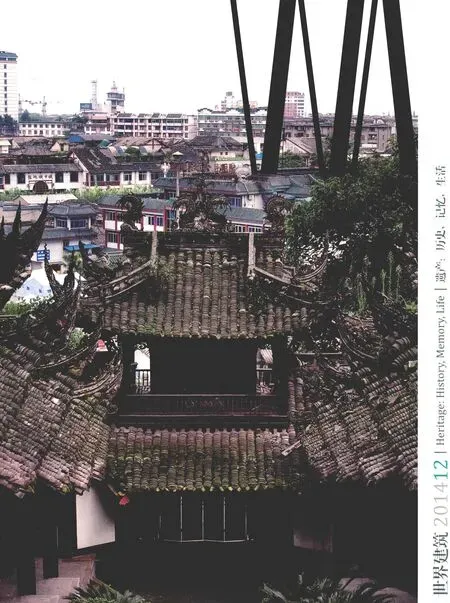南塘河历史文化街区传承与更新,宁波,浙江,中国
项目设计:陈瑶红/宁波市风景园林设计研究院
南塘河历史文化街区传承与更新,宁波,浙江,中国
项目设计:陈瑶红/宁波市风景园林设计研究院
南塘河历史文化街区位于宁波老城南门“长春门”之外,曾经是旧宁波商贸文化聚集的“南门三市”,位列宁波八大紫线规划历史文化街区之一,与南塘河、南郊路相互依存,保留了约500m的传统街巷,拥有文保单位一处,文保点6处。宋代著名学者袁燮的后裔世居于此,区域内现存的袁氏家族居宅建筑群规模最大,类型包括居住院落、祠堂、学校等。甬水桥、河埠头、前店后铺的沿街作坊、永善亭、关圣殿等共同构成南塘河历史街区丰富的历史文化内涵。南塘河的一河、一街、一市构成了该地区独一无二的风貌特征,是宁波城区内惟一一处体现江南水乡特有人居环境景观的特色街区。
随着城市生活形态、交通方式、商业模式的变换,航运功能消逝,南门三市街区发展日渐落后,渐成外来人员的聚集地,生活条件极其简陋,环境恶劣,该区域俨然成为一个尴尬的城市区域。
核心保护区的设计在保护修复文保建筑、修缮历史建筑的原则上进行,以保留的老建筑为主框架,新建筑进行织补。街区修复尊重历史,利用河、桥、巷、院落等资源,保留完整的区域肌理和街巷结构,保持历史建筑原有的尺度,保留及修复极具南塘河特色的细部,营造符合南塘河文脉与自然环境的历史情境。
所有的做法都是老工匠采用老材料、老工艺完成,力求达到朴实、恬静、雅致的传统美感;且从地面铺装、景观造景、树种选择、灯光配置、标志标识等各方面谨慎设计,塑造街区整体气氛。
插建织补的建筑和保留建筑均是木结构,或成片,或相连,对消防极为不利,且无法符合消防规范。该项目专门制定了消防专篇和保障方案,与消防专家进行专项评审讨论,由项目运营公司配备专门的小型消防车和消防保安队,负责保障整个街区的消防安全,得到宁波消防部门的一致认可。
整个项目运营中,定位于宁波民俗文化,立足老宁波传统风味,引进了宁波一副、宁波汤团、油攒子、豆酥糖、赵大有糕团、梅龙镇等传统宁波小吃糕点及老品牌,展现老街市集的韵味。且在元宵、清明、端午、中秋、重阳等时节开展灯会、演出、集市等传统活动。从建筑到意境,从商业到人文,全方位用心经营老街区,得到广大群众的喜爱和好评。
历史街区的旧躯壳与现代生活方式的矛盾是实际存在的,南塘河历史街区的改造在尊重历史的框架下进行,借助街区的历史文化资源来与新业态进行结合,在这些老建筑中加入现代的功能,实现兼顾共存。既要人们在此间找到旧日情怀,慰藉怀旧的心绪,同时又能找到新的功能和惊喜,使人们在古与今之间找到认同,让历史街区一直活下去。
目前,南塘河历史文化街区一期项目已于2013年1月开街迎客,二期正抓紧施工中,预计2015年第三季度建成开放。
项目信息/Credits and Data
占地面积/Site Area:69900m2,其中文保建筑用地/ Historic Architecture Area:4700m2
地上建筑面积/Above-ground Floor Area:约55568m2,其中文保修缮/Restoration Area:4500m2
Nantang River historic conservation area is located outside the "Changchun Gate" of the south gate in the old city of Ningbo, which once was "three markets of the south gate" where the trade and culture in Ningbo gathered. It boasts as one of the eight purple line planning historic conservation areas in Ningbo, which is interdependent with Nantang River and Nanjiao Road, preserving traditional streets of more than 500 meters. There are also a heritage conservation unit and 6 heritage conservation sites. One river, one street and one market of Nantang River constitute the unique outlook and character of the area, which is the only townscape area showing the special human living environment landscape of Jiangnan water town in the city of Ningbo.
With transformation of the urban lifestyle, changes of means of transportation and business model, the original function of shipping has disappeared; the area development of three markets of the south gate is increasingly lagging behind, which has gradually become the gathering place for floating population, with extremely poor living conditions and harsh environment. The region has become an embarrassing urban area.
The core conservation area is designed on the principles of preserving and repairing original cultural heritage buildings as well as restoring historic buildings, taking preserved old buildings as the main framework, and renovating new buildings. For the area restoration, the projects respects its history, uses resources such as the river, bridge, alley, and courtyard, keeps integral regional fabrics as well as structure of streets and alleys, maintains the original scale of historic buildings, reserves and restores details with full characteristics of Nantang River, and creates the historical context in line with the cultural and natural environment of Nantang River.
All practices are completed by old craftsmen using old materials and old process, striving to achieve a simple, quiet and elegant traditional beauty. Everything is carefully designed, from floor coverings to landscaping, tree species selection, lighting configuration, logos and signs, etc., creating an overall atmosphere of the area.
Restored and preserved buildings are clusters of buildings or interconnected buildings with timber structure, which is extremely unfavorable to the fire protection, and does not comply with fire specifications. This project specifically prepares the fire special writing and security program, for a special review and discussion with fire experts. The project operating company has a dedicated mini fire truck and a fire security team, which is responsible for guaranteeing fire safety throughout the area, and is unanimously recognized by the fire authority of Ningbo.
In the operation, the project is positioned in the folk culture of Ningbo based on the traditional flavor of old Ningbo, introducing traditional Ningbo snacks and old brands, showcasing the charm of old streets and markets, and carrying out traditional activities such as lantern festival, performances and fairs. From architecture to artistic conception, from business to humanities, the old area is operated in a comprehensive and careful way, which has won the love and praise from the masses.
The contradiction between the old shell of the historic area and modern lifestyle is actually exist, and the transformation of the Nantang River historic area is carried out under the framework of respect for the history, combining the historical and cultural resources of the area with the new types of operation, adding modern functions to these old buildings, so as to strike a balance and achieve coexistence. The project not only allows people to recall old feelings of this area to sooth their nostalgia, but also delivers modern new features and surprises for people to find identity between ancient and new, thus keeping the historic area alive forever.
At present, the first phase of the project has been put into operation in January 2013, and the second phase is speeding up on construction, which is expected to complete in the third quarter of 2015.
评论
朱光亚:后工业社会需求中应运而生的古街“打造”热潮火遍大江南北,并非所有这类项目都和真实的历史文化载体的保护有关,但名城的聚落类建筑遗存的保护若能和古街的策划结合起来,无疑使它们的可利用性有所提高,并由此获得相应的保护机会。不同的阶层对古街有不同的期待,留下城市的真实记忆对后代来说最为重要,在修缮工程中认真修复遗存和适当复建以及新建部分如何摆脱标准化的面孔都是让游客和后代满意的基本着力点,宁波古城似乎接受了大拆大建的教训,南塘古街发力于古街的修缮,宁波在进步。
张利:在非旅游取向的旧城保护项目中,传统餐饮业的存在是个幸运的元素,如果赶上特色的传统食品加工业态的存在的话,那么可谓是幸运中的幸运,因为这会为建成后区域的人气提供足够的保证。南塘老街的幸运就在于,可以以久负盛名的宁波第一副食品商店为锚固点,吸纳一波又一波的甬味小吃加工与销售于街区之内,与保留的文物建筑共同编织在一片尺度宜人的肌理之内,修葺、复建、新建等不同程度的干预结果能积极共存,已经成为受本地人喜爱的场所,这是项目成功与否的最好实证。唯一的缺憾是街区没有把河对岸纳入进来,所以临河的潜力尚未得到充分的发挥。
Comments
ZHU Guangya: Old street renovation that arises on the demand of the postindustrial society is popular all over China, but not all such projects aim at protecting the historical and cultural carrier. There is no doubt that to combine the conservation of architectural remains and old street planning would create an opportunity for the utilization and conservation of the architectural settlements in the historic city. People from different layers of the society may have different expectations for the old street, what is the most important is to remain the genuine memories for the future generations. As a result, the project should focus on restoring remains, appropriately reconstruction, as well as how to help the newly-developed part get rid of the standardized facade, for the purpose of satisfying the demands of visitors and later generations. It seems that Ningbo Old City has learned a lesson from the largescale demolition and construction by starting with the Nantang Old Street renovation, which indicating that Ningbo is making a progress.
ZHANG Li: It is lucky to have traditional food stores in a preservation project. It is the luckiest to have the making of traditional foods on site because they are the guarantee of future popularity. Nantang Old Street does have the luck of having the widely respected old Ningbo 1st Grocery Store as the anchor point, attracting more and more traditional Ningbo food stores (making and selling) into the district. New stores and old buildings speak well with each other, whether repaired, restored, or newly added. The district is a popular place among locals already, a solid proof of the success of the project. If there is anything left to be desired, it is the riverfront. Had the project included both sides of the river, the potentials of the water front could have been exploited.
Inheritance and Renovation of Nantang River Historic Conservation Area, Ningbo, Zhejiang, China, 2012
Project Design: CHEN Yaohong/Ningbo Landscape Architecture Design and Research Institute Co., Ltd.

